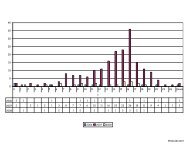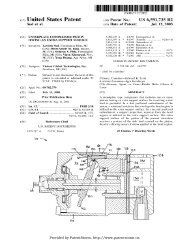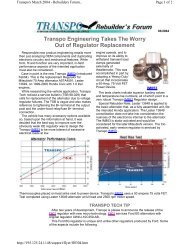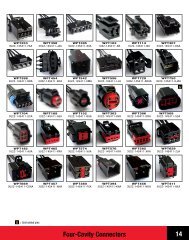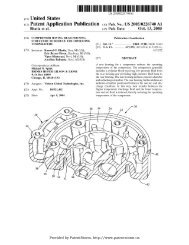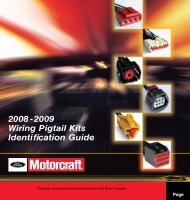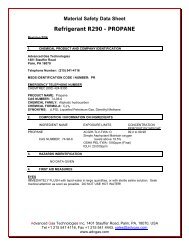SPEED CONTROL DIAGNOSTICS—W/O SCP TSB 06-8-5
SPEED CONTROL DIAGNOSTICS—W/O SCP TSB 06-8-5
SPEED CONTROL DIAGNOSTICS—W/O SCP TSB 06-8-5
Create successful ePaper yourself
Turn your PDF publications into a flip-book with our unique Google optimized e-Paper software.
<strong>SPEED</strong> <strong>CONTROL</strong> <strong>DIAGNOSTICS—W</strong>/O <strong>SCP</strong> <strong>TSB</strong> <strong>06</strong>-8-5<br />
FORD:<br />
LINCOLN:<br />
2000-2003 Escort 2000-2002 Navigator<br />
2000-2004 Crown Victoria, Mustang 2001-2002 Blackwood<br />
2000-2005 Focus, Taurus<br />
MERCURY:<br />
2000-2001 Explorer<br />
2000-2002 Cougar<br />
2000-2004 E-Series, Expedition, F-150,<br />
2000-2004 Grand Marquis<br />
F-Super Duty<br />
2000-2005 Sable<br />
2000-2005 Excursion, Ranger<br />
2003-2004 Marauder<br />
2001-2003 Explorer Sport<br />
2000-2001 Mountaineer<br />
2001-2005 Escape, Explorer Sport Trac<br />
2005 Mariner<br />
2004 F-150 Heritage<br />
ISSUE<br />
2. Visually inspect the servo and accelerator<br />
Stand-alone speed control system diagnostic<br />
controls:<br />
updates have been made in 20<strong>06</strong> model year and<br />
newer Workshop Manuals (WSM). These diagnostic • Visually inspect speed control cable without<br />
updates also apply to 2000-2005 model year<br />
removing and ensure smooth cable operation.<br />
vehicles. This <strong>TSB</strong> provides these WSM updates for<br />
Inspect cable connection to the throttle body<br />
2000-2005 model year vehicles.<br />
• Visually inspect accelerator cable without<br />
removing and ensure smooth cable operation.<br />
ACTION<br />
Inspect cable connection to throttle body.<br />
The vehicles in this article are equipped with a<br />
Also check for interference with carpet,<br />
10-pin speed control servo without a standard<br />
bulkhead grommet, insulation, and instrument<br />
corporate protocol (<strong>SCP</strong>) communication control<br />
panel wiring<br />
system. Follow the Service Procedures and<br />
Diagnostic Tips in this <strong>TSB</strong> to assist with accurate SERVICE PROCEDURE<br />
diagnosis and repair of speed control issues.<br />
Start by running speed control servo integrated self<br />
GENERAL SERVICE PROCEDURE<br />
test diagnostics. The servo has integrated self test<br />
diagnostics which is a key tool in quickly and<br />
1. Visually inspect the vehicle. Any after market accurately diagnosing speed control system faults.<br />
modifications, including but not limited to those Self test diagnostics are also the basis for starting<br />
listed below, may cause speed control to not speed control trouble shooting.<br />
operate correctly:<br />
WARNING<br />
• Any wiring or lamp modifications affecting<br />
THIS TEST IS A KEY ON ENGINE OFF (KOEO)<br />
brake lamp operation<br />
TEST THAT IS CONDUCTED ONLY WHILE<br />
• LED brake lamps<br />
PARKED WITH THE PARKING BRAKE FULLY<br />
• Non-factory installed trailer wiring<br />
ENGAGED. FAILURE TO FOLLOW THESE<br />
• Radios (speed sensitive, auto mute)<br />
INSTRUCTIONS MAY RESULT IN PERSONAL<br />
• Remote starters and alarms<br />
INJURY.<br />
• Lighting and electrical accessories<br />
modifications<br />
NOTE: The information in Technical Service Bulletins is intended for use by trained, professional technicians with the knowledge, tools, and equipment to do<br />
the job properly and safely. It informs these technicians of conditions that may occur on some vehicles, or provides information that could assist in proper<br />
vehicle service. The procedures should not be performed by “do-it-yourselfers”. Do not assume that a condition described affects your car or truck. Contact a<br />
Ford, Lincoln, or Mercury dealership to determine whether the Bulletin applies to your vehicle. Warranty Policy and Extended Service Plan documentation<br />
determine Warranty and/or Extended Service Plan coverage unless stated otherwise in the <strong>TSB</strong> article.The information in this Technical Service Bulletin<br />
(<strong>TSB</strong>) was current at the time of printing. Ford Motor Company reserves the right to supercede this information with updates.The most recent information is<br />
available through Ford Motor Company’s on-line technical resources.<br />
Copyright © 20<strong>06</strong> Ford Motor Company Online Publication Date April 6, 20<strong>06</strong> PAGE 1
<strong>TSB</strong> <strong>06</strong>-8-5 (Continued)<br />
NOTE c. The speed control indicator lamp on the<br />
THE SELF-TEST IS COMPRISED OF TWO<br />
instrument panel will flash once to indicate<br />
PARTS. THE FIRST PART IS A STATIC CHECK<br />
that the speed control module has entered<br />
OF THE <strong>SPEED</strong> <strong>CONTROL</strong> ELECTRONICS<br />
the self test diagnostic mode. Release the<br />
MODULE AND SYSTEM. THE SECOND PART IS<br />
OFF switch. If 5 flashes are displayed at<br />
A DYNAMIC PULL-TEST TO CHECK THE<br />
this point, a speed control subsystem<br />
ACTUATOR MOTOR AND GEAR MECHANISM.<br />
concern exists. Refer to the Symptom Chart<br />
in the vehicle WSM.<br />
NOTE<br />
THE MODULE TIMES OUT IF EACH BUTTON IS<br />
d. Then firmly press and release the remaining<br />
NOT PRESSED WITHIN 1 SECOND OF THE<br />
switches WITHIN 1 SECOND of each other<br />
PREVIOUS BUTTON. IF A MODULE TIME OUT<br />
in the sequence below. The speed control<br />
OCCURS (<strong>SPEED</strong> <strong>CONTROL</strong> LAMP STOPS<br />
indicator lamp flashes once after each of the<br />
FLASHING PART WAY THROUGH THE TEST),<br />
buttons is successfully pressed.<br />
THE PROCEDURE MUST BE RE-INITIATED.<br />
NOTE<br />
ON VEHICLES EQUIPPED WITH A MANUAL<br />
TRANSMISSION, THE CLUTCH PEDAL SHOULD<br />
NOT BE DEPRESSED EXCEPT FOR<br />
ESCAPE/MARINER, WHICH SHOULD BE<br />
DEPRESSED, IN ORDER TO CORRECTLY<br />
PERFORM THE SELF-TEST. ON VEHICLES<br />
EQUIPPED WITH AN AUTOMATIC<br />
TRANSMISSION, THE TRANSMISSION<br />
SELECTOR LEVER NEEDS TO BE IN THE “P”<br />
POSITION FOR THE SELF TEST EXCEPT FOR<br />
THE ESCAPE/MARINER WHICH SHOULD BE IN<br />
“N”.<br />
NOTE<br />
REVIEW THE FOLLOWING STEPS BEFORE<br />
CARRYING OUT THE SELF-TEST DIAGNOSTIC<br />
PROCEDURE.<br />
Figure 1 - Article <strong>06</strong>-8-5<br />
NOTE<br />
MONITOR THE PCM THROTTLE POSITION PID<br />
AFTER THE LAST BUTTON IS PRESSED.<br />
1. Self Test Diagnostic Procedure - Static Test<br />
NOTE<br />
THERE WILL BE A SLIGHT DELAY FROM WHEN<br />
a. Connect the diagnostic scan tool (DST) to a THE LAST BUTTON IS PRESSED AND THE<br />
power source that is not interrupted when CLUSTER LAMP FLASHES DIAGNOSTIC CODES.<br />
the ignition switch changes positions. With<br />
the ignition switch in the RUN position, set NOTE<br />
the DST to monitor the powertrain control IF THE SELF-TEST WILL NOT START OR<br />
module (PCM) throttle position PID while the CANNOT BE COMPLETED AFTER MULTIPLE<br />
speed control actuator carries out the<br />
ATTEMPTS, GO TO THE VEHICLE WSM<br />
self-test.<br />
SYMPTOM CHART.<br />
b. Enter self-test diagnostics by firmly pressing<br />
and holding the speed control OFF switch<br />
while quickly cycling the ignition switch from<br />
RUN-to-OFF-to-RUN, making sure the<br />
engine does not start and is not running.<br />
e. Follow the list below for diagnostic flash<br />
codes, then go to the WSM Symptom Chart.<br />
PAGE 2
<strong>TSB</strong> <strong>06</strong>-8-5 (Continued)<br />
Figure 2 - Article <strong>06</strong>-8-5<br />
2. Self Test Diagnostic Procedure - Dynamic Test <strong>SPEED</strong> <strong>CONTROL</strong> DIAGNOSTIC TIPS<br />
NOTE<br />
Servo Pin-Out Test Tips<br />
THE DYNAMIC TEST OCCURS AUTOMATICALLY<br />
AFTER THE STATIC TEST PASSES. IF THE<br />
NOTE<br />
STATIC TEST FAILS RESULTING IN FLASH<br />
MEASURING THE RESISTANCE OF A SERVO<br />
CODES, THERE WILL BE NO DYNAMIC PULL WILL INDICATE THAT A SERVO IS BAD IF<br />
TEST.<br />
READINGS ARE OUTSIDE THE RANGES<br />
SPECIFIED BELOW. HOWEVER, A SERVO CAN<br />
a. Within .25 seconds after the static test has HAVE RESISTANCE READINGS WITHIN THE<br />
completed, the speed control actuator<br />
SPECIFIED RANGES AND STILL BE FAULTY.<br />
carries out a dynamic pull test. The actuator<br />
automatically pulls the speed control cable The following readings are the expected values for<br />
.04 to .39″ (1 to 10 mm) to move the<br />
a good servo.<br />
throttle from the idle position and then<br />
Resistance between Pins 6 and 10 should measure<br />
releases the speed control cable returning less than 5 ohms. This is the ground circuit through<br />
the throttle to the idle position.<br />
the module. Resistance between Pins 7 and 10 will<br />
NOTE<br />
vary with polarity, the type of meter, and source<br />
THE 2001-2005 ESCAPE/MARINER HOLDS THE<br />
voltage of the meter. Also measurements between<br />
PEAK THROTTLE PULL FOR 3 SECONDS PRIOR<br />
Pins 7 and 10 can be any of the following: an open<br />
TO RELEASING.<br />
circuit, increasing reading (as a capacitor charging),<br />
or changing value (re-apply leads and different<br />
b. If the throttle position PID voltage value value indicated), or a stable reading of 10,000 ohms<br />
does not change during the dynamic throttle or greater are all valid results as this is a solid<br />
pull, go to the WSM Symptom Chart Section state circuit.<br />
for Dynamic Pull Test failure.<br />
DST Testing Tips (TPS PID)<br />
1. Pinpoint Test: The Speed Control Does Not<br />
Disengage When The Brakes Are Applied<br />
PAGE 3
<strong>TSB</strong> <strong>06</strong>-8-5 (Continued)<br />
With the vehicle speed above 30 MPH (48 Km/h) 3. Start the vehicle; place the transmission in<br />
engage the speed control. Then check to see if the DRIVE, test drive vehicle between 25-30 MPH<br />
TPS PID returns to base voltage when the brakes<br />
(40-48 Km/h).<br />
are applied. If it does return to base voltage, then<br />
the speed control system is working. Need to<br />
4. Measure the frequency between the speed<br />
advise customer that tapping the brakes deactivates control actuator C122 Pin 3 harness side and<br />
speed control and that the brakes must be applied<br />
C122 Pin 10 (ground) harness side. Divide<br />
to make the vehicle slow down. On the<br />
frequency by 2.2 to give MPH and compare to<br />
Escape/Mariner the brake pedal should be<br />
speedometer reading. Measure AC Volts and<br />
depressed at least 13/32″ (10 mm) in order to<br />
record.<br />
deactivate speed control. 5. If the AC Voltage is greater than 4.5V and the<br />
NOTE<br />
frequency reading does match the speedometer<br />
CHECK FOR CALIBRATION SERVICE MESSAGES<br />
reading then the speed signal is valid. If further<br />
RELATING TO DASHPOT OR IDLE <strong>SPEED</strong><br />
diagnostics are required see WSM.<br />
<strong>CONTROL</strong> UPDATES.<br />
Deactivator Switch Inspection Tips<br />
2. Pinpoint Test: The Speed Control Does Not A faulty deactivator switch can result in intermittent<br />
Disengage When The Clutch Is Applied<br />
or inoperative speed control. There are two types of<br />
Check to see if the TPS PID returns to base<br />
deactivator switches; a brake line pressure switch,<br />
voltage when the clutch is pressed. If it does then<br />
which is integrated into the brake master cylinder,<br />
the speed control system is working. Need to<br />
and a pedal travel switch, which is connected to the<br />
advise customer that pressing clutch deactivates<br />
brake pedal arm.<br />
speed control and that the brakes must be applied Proper switch function should be confirmed.<br />
to make the vehicle slow down.<br />
Inoperative switches of both types should be<br />
NOTE<br />
inspected for connector corrosion or pin push-out.<br />
Pedal travel switches should also be inspected for<br />
CHECK FOR CALIBRATION SERVICE MESSAGES<br />
proper mechanical adjustment relative to brake<br />
RELATING TO DASHPOT OR IDLE <strong>SPEED</strong><br />
pedal travel.<br />
CHANGES. ALSO A SLIGHT ENGINE RPM FLARE<br />
MAY OCCUR ON SOME VEHICLES WHEN<br />
ADDITIONAL REFERENCE INFORMATION<br />
<strong>SPEED</strong> <strong>CONTROL</strong> IS DISENGAGED WHICH IS A<br />
NORMAL CONDITION.<br />
Speed Control Servo Operation and Function<br />
Speed Signal Testing Tips<br />
NOTE<br />
ALL FUNCTIONALITY LISTED BELOW IS<br />
NOTE<br />
PERFORMED WITH CONNECTORS CONNECTED<br />
A FAULTY VEHICLE <strong>SPEED</strong> SIGNAL TO THE AND KEY IN RUN POSITION UNLESS<br />
SERVO CAN RESULT IN INTERMITTENT,<br />
OTHERWISE NOTED.<br />
IRREGULAR OR INOPERATIVE <strong>SPEED</strong><br />
<strong>CONTROL</strong>.<br />
PIN 1 - Indicator. (if used) Speed control servo<br />
grounds this circuit to turn the speed control lamp in<br />
NOTE<br />
cluster on during operation. This will not affect<br />
FOR VEHICLES THAT HAVE OSS OR HALL<br />
operation of system.<br />
EFFECT VEHICLE <strong>SPEED</strong> SIGNALS TO THE<br />
SERVO, REFER TO WSM FOR DIAGNOSTICS. PIN 2 - Clutch/TRS Input. (Escape/Mariner only)<br />
Signal comes from clutch switch (MT) or TRS (AT).<br />
To verify that the speed control signal sent to the On the harness side the signal can be measured by<br />
servo is valid, the following inspection may be done connecting a DVOM, set to ohms, between Pins 2<br />
for ABS and PCM generated speed signals:<br />
and B-. With clutch depressed (MT) or in N (AT)<br />
1. Disconnect speed control module (C122).<br />
you should read 0 ohms, which disables speed<br />
control. With clutch released (MT) or in D (AT)<br />
2. Connect DVOM set to Hz to C122 Pin 3<br />
signal should read greater than 10,000 ohms, which<br />
harness side and C122 Pin 10 (ground)<br />
enables speed control operation.<br />
harness side.<br />
PAGE 4
<strong>TSB</strong> <strong>06</strong>-8-5 (Continued)<br />
PIN 3 - VSS Input. (Note: Performed with engine<br />
running and vehicle driven.) Signal comes from<br />
PCM, ABS, OSS, hall effect sensor depending on<br />
application. Except for hall effect sensor, the signal<br />
can be measured by removing Connector C122 and<br />
measuring the frequency between Pins 3 and 10<br />
with a DVOM set to AC Hz. The signal should<br />
measure 2.2 Hz/MPH. The vehicle must be traveling<br />
30 MPH (48 Km/h) before the system will set,<br />
therefore a minimum of 66 Hz must be observed.<br />
Take note that on vehicles equipped with SVC<br />
(speed sensitive volume control), an internal<br />
problem within the radio can bring signal down to 0<br />
Hz even though it reads correctly in PCM PIDs. If<br />
signal is missing disconnect radio and retest. Note, Figure 3 - Article <strong>06</strong>-8-5<br />
for vehicles with a hall effect input to the speed<br />
control servo, see WSM for speed signal<br />
PIN 6 - Control Switch Return. This is the return<br />
verification.<br />
side of the switches, which are grounded internally<br />
to the servo to Pin 10. If test for Pin 5 checks good<br />
PIN 4 - Brake Switch Input (BOO/BPP).<br />
then Pin 6 is functioning normally.<br />
NOTE<br />
ENSURE THAT BRAKE LAMPS ARE<br />
FUNCTIONING CORRECTLY.<br />
Vehicles with automatic transmission and all Escape<br />
and Mariner vehicles (auto and manual): With a<br />
DVOM set to ohms, measure resistance between<br />
Pins 4 and B- with brake pedal not depressed, you<br />
should get less than 5 ohms. Then measure voltage<br />
with brake pedal depressed, you should get 12 V.<br />
Operation: The servo sends out a reference voltage<br />
on Pin 4 (4-7V) which is grounded through the<br />
brake lamps or switched directly to ground.<br />
Vehicles with manual transmissions (except Escape<br />
and Mariner vehicles, see above): With a DVOM set<br />
to ohms, measure resistance between Pin 4 and B-<br />
with brake pedal not depressed and clutch pedal<br />
not depressed, you should get less than 5 ohms.<br />
Next, depress clutch pedal only, measuring<br />
resistance, you should get an open circuit / infinite<br />
resistance. Then measure voltage with brake pedal<br />
depressed, clutch pedal not depressed and you<br />
should get 12 V. Repeat with both pedals<br />
depressed and you should get 0 volts. Operation:<br />
The servo sends out a reference voltage on Pin 4<br />
(4-7V) which is grounded through the brake lamps<br />
or switched directly to ground when the clutch pedal<br />
is not depressed.<br />
PIN 5 - Control Switch Input. (Note: Performed with<br />
key in OFF position.) Remove Connector C122,<br />
using a DVOM set to resistance, measure the<br />
resistance between Pins 5 and 6. See table of<br />
resistance readings below for each switch when it is<br />
depressed.<br />
PIN 7 - Power. Remove Connector C122, Using a<br />
DVOM set to DC volts, measure the voltage<br />
between Pin 7 and ground. You should read greater<br />
than 10 volts with the key in the run position.<br />
Record the voltage from Pin 7 to ground, then<br />
re-measure with a test lamp (1156) from Pin 7 to<br />
ground, to ensure current carrying capability. The<br />
difference between the two measurements should<br />
be less than 0.3 VDC. If voltage drop test fails then<br />
check wiring.<br />
PIN 8 - Not used.<br />
PIN 9 - Brake Deactivator Switch (BPS). This is a<br />
redundant shutoff switch. Without depressing the<br />
brake pedal, measure voltage on Pin 9, and<br />
re-measure with a test lamp (1156) from Pin 9 to<br />
ground, to ensure current carrying capability. The<br />
difference between the two measurements should<br />
be less than 0.3 VDC. The system requires enough<br />
current at this pin to engage properly. If voltage<br />
drop test fails, check for corroded wiring or<br />
deactivation switch. You should measure 0 volts at<br />
Pin 6 when the brake pedal is depressed firmly.<br />
An alternate to the voltage drop test would be to<br />
disconnect the switch connector and measure the<br />
switch resistance. It should be less than 5 ohms. If<br />
the switch is suspected, a bypass test may also be<br />
done: On the harness side of the BPS connector,<br />
connect a jumper between the two deactivation<br />
switch pins and drive vehicle above 30 MPH (48<br />
Km/h). If speed control engages then the brake<br />
deactivation switch was faulty, otherwise wiring is at<br />
fault.<br />
PAGE 5
<strong>TSB</strong> <strong>06</strong>-8-5 (Continued)<br />
PIN 10 - Ground. Using a DVOM set to DC volts,<br />
measure the voltage between B+ and Pin 10. You<br />
should read greater than 10 volts. Record the<br />
voltage between B+ and Pin 10 , then re-measure<br />
with a test lamp (1156) from B+ to Pin 10. The<br />
difference between the two measurements should<br />
be less than 0.3 VDC. If voltage drop test fails then<br />
check wiring. This verifies circuit can carry proper<br />
load as well as continuity to ground.<br />
WARRANTY STATUS: Information Only<br />
PAGE 6



